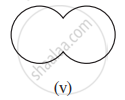Advertisements
Advertisements
प्रश्न
Can we have two obtuse angles whose sum is an acute angle? Why or why not?
उत्तर
Yes, ∵ The sum of two obtuse angles is always greater than 180°.
E.g. 135° and 100° are two obtuse angles and their sum = 135° + 100° = 235°, which is greater than 180°.
APPEARS IN
संबंधित प्रश्न
Given here are some figures:
 |
 |
 |
 |
 |
 |
 |
 |
Classify each of them on the basis of the following:
- Simple curve
- Simple closed curve
- Polygon
- Convex polygon
- Concave polygon
The measure of angles of a hexagon are x°, (x − 5)°, (x − 5)°, (2x − 5)°, (2x − 5)°, (2x + 20)°. Find the value of x.
In a convex hexagon, prove that the sum of all interior angle is equal to twice the sum of its exterior angles formed by producing the sides in the same order.
The sum of the interior angles of a polygon is three times the sum of its exterior angles. Determine the number of sided of the polygon.
In the given figure, PQRS is an isosceles trapezium. Find x and y.

In a trapezium ABCD, side AB is parallel to side DC. If ∠A = 78° and ∠C = 120. find angles B and D.
The angles of a quadrilateral are in the ratio 2 : 4 : 5 : 7. Find all the angles
If angles A, B, C and D of the quadrilateral ABCD, taken in order, are in the ratio 3 : 7 : 6 : 4, then ABCD is a ______.
The number of right angles in a straight angle is ______ and that in a complete angle is ______.
In given figure, What is BD – DE?
